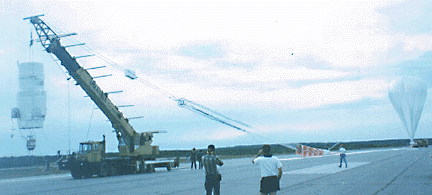|
|
|
|
Tell Me About Flying Cosmic Ray Detectors On Balloons
Since cosmic rays do not penetrate very far into the earth's atmosphere,
cosmic ray instruments have to get above most of the atmosphere. Satellites
are excellent platforms for cosmic ray research, but a much less expensive
method is to use high-altitude unmanned balloons. NASA has an active balloon
program flying huge helium research balloons at altitudes of 40 km, above
99.5% of the atmosphere. The balloons fly for one or more days, after which
the payloads return to the ground on a parachute. These payloads can weigh
several tons, considerably larger than the typical satellite experiment,
and have returned some of the most valuable results in cosmic ray research.
They also serve as inexpensive test-beds for satellite missions of the
future.

Examples of cosmic-ray balloon include IMAX (http://lheawww.gsfc.nasa.gov/docs/gamcosray/hecr/imax.html)
(the Isotope Matter-Antimatter eXperiment pictured above) and ISOMAX (http://lheawww.gsfc.nasa.gov/docs/gamcosray/hecr/ISOMAX/)
(the ISOtope Magnet eXperiment).
|
|
